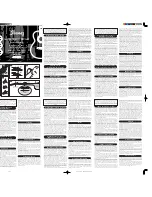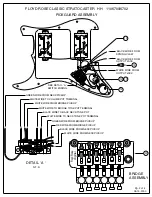
Depending on your playing style, an extremely low action
setting may contribute to fret buzz. When occurring because
of low action, this is not considered to be a defect in the
instrument. If you are in doubt about the action setting of
your Roundback, consult your Ovation Dealer.
The saddle carries the string load to the top of your guitar.
As the top and its supporting brace structure flexes with the
environment, the saddle may settle into a position different
than when set in the factory's controlled environment.
Sometimes the movement of the saddle can change the
action setup. In this case, adjust the saddle height with
the shims as described above.
Please note however, that
the factory-recommended maximum distance from the
Loosen or remove the
strings.
Lift and rotate the
saddle carefully out of
the bridge slot. This is
a delicate operation,
particularly if you have
an acoustic-electric
model. Be certain not
to pull or force the wiring
beneath the saddle.
For lower than standard
action, remove the shim
beneath the saddle.
Removing one shim will
lower the action by 1/64"
at the 12th fret.
1.
2.
3.
requirements of a broad range of players. If you need to
adjust the action, use the following procedure:
16
bottom of the strings to the top of the bridge is 6/32"
while
the minimum distance is 2/32".
The standard factory actions,
in 64ths of an inch measured from the top of the 12th fret to
the bottom of the string:
Acoustic & Acoustic/
Electric
Models
Minimum
5
4
Nominal
6
4
Maximum 7
5
Classic
Minimum
8
7
Nominal
9
8
Maximum 10
9
Acoustic Bass
Minimum
6
5
Nominal
7
6
Maximum 8
7
Mandolin
Minimum
4
3
Nominal
5
4
Maximum 6
5
Mandocello
Minimum
6
5
Nominal
7
6
Maximum 8
7
Measured at: Bass/Treb
Checking and Adjusting the Neck
The neck is certainly one of the most environmentally dynamic
elements in a guitar. While every effort is taken to select only
the best materials and finishes, shrinkage or expansion due
to environmental conditions is inevitable. These dimensional
variations, in addition the forces created by string tension,
can cause the neck to bend.
Two common conditions can arise when dimensional changes
occur within the neck assembly, or if string gauges are
changed. These are called warp and bow.
Fig. 10
, a view
sighting down the neck from the tuning machines, depicts
a warped condition where the headstock is bending toward
the strings.
Fig. 10a
is a side view of this condition.
17




















